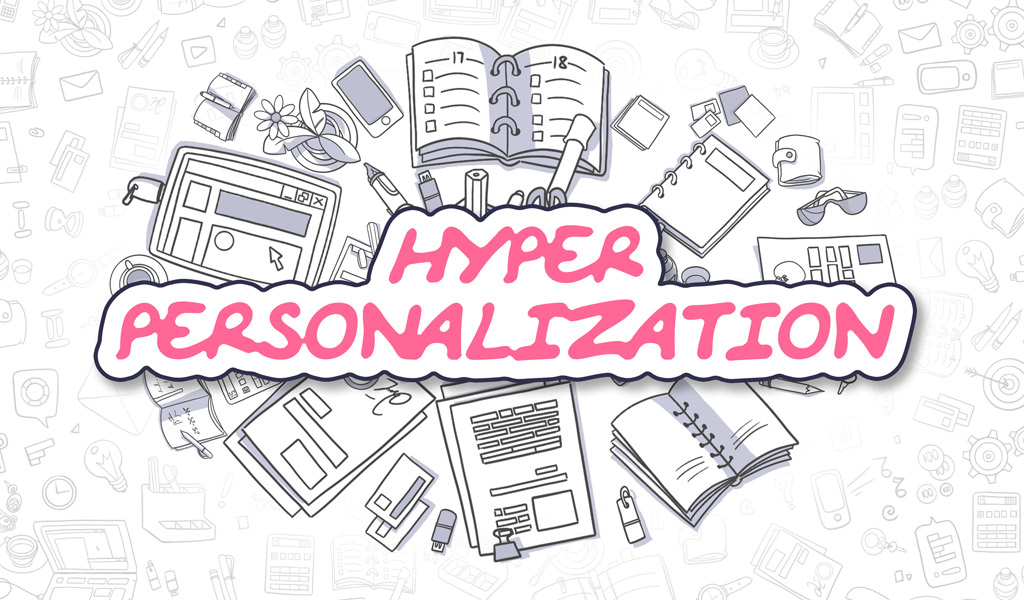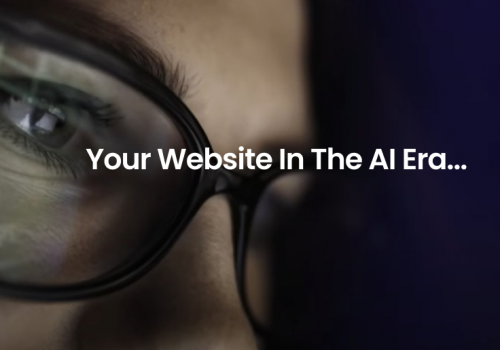Hyper-Personalization. Hyper-personalization is a buzzword you’ve almost definitely heard by now. But what exactly is it? How do you implement it? And why is it so crucial for marketers in 2021? Let’s take a look.
What is Hyper-Personalization?
Hyper personalization combines behavioral, historical, and real-time data extracted from multiple touchpoints to create highly customized consumer experiences.
What’s the Difference Between Personalization and Hyper-Personalization?
Most brands use some form of personalization in their marketing, but much fewer brands employ hyper-personalization. Hyper-personalization is essentially personalization but on steroids.
Hyper-personalization utilizes much more customer data in its approach than a traditional personalization approach would. A traditional personalization approach uses data to categorize customers into segments, and run campaigns focused on those segments. This approach works and definitely has its place, particularly for broader marketing campaigns where you want to attract new customers. However, if you want to encourage existing customers to take action (buy more products or upgrade their package), you’ll get a much higher conversion rate with a hyper-personalized approach.
In a hyper-personalization approach, each customer is essentially in a segment on their own. They are unique, and the content they see is specific to their circumstance. They’re not receiving an email because they are in an age bracket (18-24) or because they recently had a child. Instead, they’re receiving the email or ad because your data suggests they specifically, not their segment, will want to see it. Let’s look at some examples:
Example 1
Personalization: Advertising summer clothes to someone who bought similar items the year before.
Hyper-personalization: Analyzing the exact time, location, payment method the customer used, and their social media activity to give them an ad that’s likely to convert.
Example 2
Personalization: A user browsed clothes on a Saturday night but didn’t buy anything. They spent the most time looking at suits. The company sends them an email with upcoming sale items later in the week.
Hyper-personalization: The customer expressed interest in suits on a Saturday night. This could mean that Saturday nights are when they relax and have time to do some online shopping, so approaching them at this time will allow them to take action immediately. You also know they are most interested in finding a new suit. On a Saturday evening, you send them a coupon or advertise a sale on suits.
Why Hyper-Personalization is the Future
It’s 2021, and today, marketing is a science. Here are the reasons why you should get started straight away with hyper-personalization:
Engagement
A recent study by the Epsilon Group found that 80% of consumers are more likely to buy when the brand offers are personalized.
Relevance
Getting the right message in front of your consumers drives conversion rates through the roof. When we see content that is irrelevant to our situation, we switch off. Not only do we switch off, but we are reluctant to see more content from the company. We believe they don’t understand who we are or what we want.
Trust
When engagement and relevance are high, trust naturally follows. When consumers trust your company, they see you as an authority. You become their go-to option for certain products because they can count on your competency and ability to deliver what they want.

6 Steps To Get You Started With Hyper-Personalization
1. Determine the Relevant Data
A key thing you need to know about hyper-personalization is that not all data is equal. It wasn’t so long ago that hyper-personalization was completely unheard of. Today, with machine learning algorithms, it’s becoming more popular than ever. But these algorithms only work because of the data they utilize. So, what data should you be gathering to offer hyper-personalized experiences?
We can break data down into the several categories below:
Quantitative Data
- Website activity: Things the customer signs up for, product views, number of website visits, and what type.
- Social media activity: What profiles they have on Facebook, Twitter, Instagram. Additionally, what pages or content they follow, like, and retweet.
- Customer services: Whether they have contact customer services before, what complaints they have filed, and so on.
Qualitative Data
This data is usually gathered from questionnaires. The surveys aim to capture customer opinion, motivation, and attitude, either towards the brand/product. You can use this type of data to determine how likely the customer is to repurchase your products and whether anything is blocking them from buying.
Descriptive Data
This is data that isn’t numerical but can tell you a lot about the customer. For example:
- Occupation: What field/sector/job role they work in.
- Habits: Do they browse at night? What devices do they use? Do they complete purchases in one sitting or leave carts abandoned before returning?
- Lifestyle information: What type of property do they live in (house/apartment)? Do they drive a car? If so, what’s the make and model. Do they own a pet? Are they married?
2. Determine How to Gather the Data
Once you’ve decided what data to gather, next, you need to figure out how. Put simply, you should be trying to collect as much data as possible and later working out whether it’s helpful to you. With the advent of machine learning algorithms and how rapidly they are advancing, you’d be surprised at how much data is helpful to your business. You might think certain data doesn’t hold much value, but a machine learning algorithm will connect it to user behavior, and suddenly, you find a new motivator behind purchasing decisions. Not everyone will be using machine learning tools or designing their own right now, but you almost definitely will be in the future, so now is the time to start gathering.
Here are some essential tips on how to gather data:
- Use an omnichannel platform to eliminate duplicates and make data easily accessible. Duplicated or erroneous data can skew your results.
- Use automation to ensure data is consistent.
- Use Google Analytics.
- Send out surveys and questionnaires.
- Design your customer service interactions around asking important questions that can help you build excellent customer profiles.
The key to gathering data is to be deliberate and focused in your approach, but not aggressive. Remember, consumers are becoming more and more away about just how much data companies hold on them. Most consumers are happy to trade data for excellent experiences, but make sure you communicate the intent behind data gathering if you’re asking for it. For example, you can communicate that your survey’s purpose is to create better products that your customers will love.
3. What Enrichment Tools Should You Use?
Sometimes, with a new customer, you don’t have much information on them. You might only know their name, age, and email address. This isn’t a lot to go off, but it doesn’t mean you can’t start the personalization process. There are companies out there that offer enrichment services. Put simply, you can enter the data you have about someone, and they will tell you any additional information they have for a fee. This can be things like social media profiles, other purchases, and web activity.
You can also reach out to new customers straight away to start gathering data. You can either start with a survey or bake these questions into your onboarding process.
A robust onboarding process is critical to building customer loyalty because it assimilates the customer into your brand. They get a feel for how you speak, operate, and what you offer beyond their initial interest. During the onboarding process, you can encourage the user to fill out a profile that asks them key questions that reveal what marketing experiences they are likely to enjoy.

4. Experiment
A vital part of the hyper-personalization approach is experimenting. Even with all the data in the world, you won’t always get it right. And that’s fine! Sometimes you need to experiment to discover what content resonates most with certain customers.
Hyper-personalization isn’t just about getting the right content in front of the right people but also about doing it at the right time. For example, if someone only checks their emails once a month and spends as little time on the app as possible, then you’re unlikely to get great results focusing on email content. But you won’t know this until you experiment. You can start with email content, and if you don’t get any engagement, switch to the social media apps they use. You should also time the delivery of your content so that it disrupts the customer at the optimal moment. Do they tend to be more active on their device during lunch hours? Do they interact with your emails most on a Friday? Be deliberate in your approach.
5. Use Various Channels
Leading on from the last point, never rely on only one channel for your hyper-personalization goals. You need to use various channels to create one-on-one relationships with customers. Just like how we adapt our behavior based on who we see (for example, mother-in-law vs. best friend), we adjust our behavior between different platforms. We might be feeling in a more relaxed mood while using Instagram than browsing our email. Email can feel like a chore to some people. We get so many emails that it can be hard to determine what is worth looking at or not. Consequently, we tend to be in a more critical mindset when browsing email than we would be when scrolling through social media (a downtime activity.
6. Consistent Messaging
This applies both to hyper-personalization and to your marketing efforts as a whole. It’s absolutely essential that your messaging, tone, and style remain consistent throughout your hyper-personalized campaigns. There are several reasons why this is so important:
- Consistency creates trust – The customer begins to know what they can expect from you. If they resonate with the content you sent them, they will be hoping to get a similar feeling from new content.
- It displays authority – It shows that you’re confident in your messaging and trusts it yourself. You’re not changing between different styles of language. Your brand knows what it is and what it represents.
So how does consistency match with experimenting? Experimenting is about tweaking your approach to find the one that a specific customer connects with the most. Being consistent is about being true to your brand (your language, values, messaging) and being reliable (we’re here, we’re always here, and you can count on us.
Another area you need to be consistent in is testing. You can use multivariate testing to identify the most compelling elements of your messaging. For example, it should come as no surprise that some words have more emotional impact on people than others. Typically, these are the words you see in the headlines of articles you read online. The editor has to use emotional words to compel you to click because otherwise, you’ll never read the post. Well, the same is true in marketing. But in a hyper-personalization approach, you are testing different words with the same users while keeping the content mostly the same in its offering and themes.




















